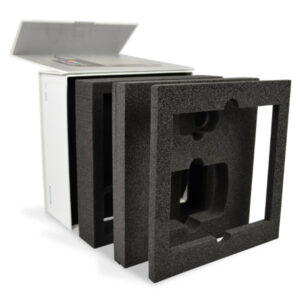
Special ESD foam that protects static-sensitive electronic devices, components, and parts for shipping and storage is a necessary solution for many of today’s devices. When choosing a foam for these types of items, it’s best to ensure that they meet EIA-541 Packaging Material Standards for ESD Sensitive Items. When it comes to choosing between anti-static and conductive foams, it helps to understand the differences between the two.
What is Anti-Static Foam?
Anti-static (ESD) foams help dissipate electro-static charges, which can easily damage sensitive electronic devices and parts. These types of foam have a surface resistance that measures between 109 – 1012 ohms and are made from a static dissipative polyurethane and polyethylene material.
Their pink coloring makes most ESD foams easy to identify. ESD foams are chemically treated with anti-static agents that allow them to not generate static charges. They prevent static from being built up by the friction of the item rubbing up against them while in motion. However, they will allow static charges to pass through them. When using this foam in shipping to fully protect static-sensitive devices, make sure the item is placed in a silver conducive bag that will shield it from outside electrostatic charges.
Generally speaking, anti-static foam is not reusable.
Static Dissipative Foam
Static dissipative foam is a type of foam that allows for static charges to flow to the ground more slowly than conductive materials. Controlling the speed in which charges go to the ground, helps the foam protect the material encased inside of it. This type of foam is generally either carbon-impregnated and colored black or surface treated and colored pink. Static dissipative foam has a low (or no) initial charge and prevents discharges to or from human contact. These types of foam have 105 to 109 ohms..
What is Conductive Foam?
Conductive foam is a type of polyethylene foam that is filled with carbon. It is generally identifiable by its black coloring and has a surface resistance of less than 106 ohms. Conductive foam protects electronic devices and components by acting as a Faraday cage, which blocks electromagnetic fields from reaching whatever it is surrounding. This type of foam makes it not necessary to place the item in something that will shield it from outside electrostatic charges. Conductive foam is known to drain batteries if their conductive ends come in contact with the foam. Be sure to shield batteries from the foam if you are using this type of foam to ship or store electronic devices by using a layer of insulation or another type of static dissipative foam.
